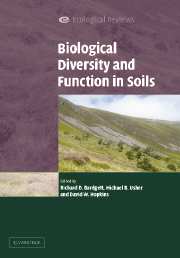Book contents
- Frontmatter
- Contents
- List of contributors
- Preface
- Acknowledgements
- PART I Introduction
- PART II The soil environment
- PART III Patterns and drivers of soil biodiversity
- PART IV Consequences of soil biodiversity
- PART V Applications of soil biodiversity
- 16 Soil biodiversity in rapidly changing tropical landscapes: scaling down and scaling up
- 17 Restoration ecology and the role of soil biodiversity
- 18 Soil biodiversity: stress and change in grasslands under restoration succession
- 19 Soil biodiversity, nature conservation and sustainability
- PART VI Conclusion
- Index
- References
17 - Restoration ecology and the role of soil biodiversity
Published online by Cambridge University Press: 17 September 2009
- Frontmatter
- Contents
- List of contributors
- Preface
- Acknowledgements
- PART I Introduction
- PART II The soil environment
- PART III Patterns and drivers of soil biodiversity
- PART IV Consequences of soil biodiversity
- PART V Applications of soil biodiversity
- 16 Soil biodiversity in rapidly changing tropical landscapes: scaling down and scaling up
- 17 Restoration ecology and the role of soil biodiversity
- 18 Soil biodiversity: stress and change in grasslands under restoration succession
- 19 Soil biodiversity, nature conservation and sustainability
- PART VI Conclusion
- Index
- References
- Type
- Chapter
- Information
- Biological Diversity and Function in Soils , pp. 319 - 342Publisher: Cambridge University PressPrint publication year: 2005
References
- 5
- Cited by

